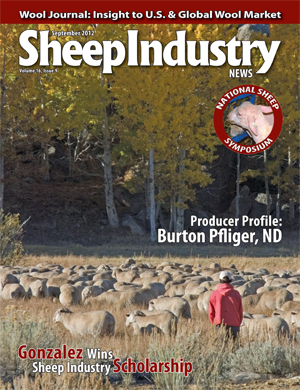
- September 2012
- Lawsuit Filed Against USFS
- Olympic Uniforms to be Made From Oregon Wool
- Additional Lamb Purchase Applauded
- Gonzalez Wins Sheep Industry Scholarship
- Symposium Uses Technology to Attack twoPLUS Initiative
- Pfliger has Sheep Industry Leadership in his Genes
- Solid Leadership Key to Success of NLPA Sheep & Goat Fund
Lawsuit Filed Against USFS
(Sept. 1, 2012) The Public Lands Council (PLC), National Cattlemen’s Beef Association (NCBA) and the American Sheep Industry Association (ASI) in August filed a lawsuit against the U.S. Forest Service (USFS), challenging its latest forest planning rule. PLC, NCBA and ASI join multiple industry organizations, such as the Federal Forest Resource Coalition, Minnesota Timber Producers Association and the California Forestry Association in filing suit, claiming that the new planning rule, finalized in March 2012, violates the National Forest Management Act (NFMA), the Multiple-Use, Sustained-Yield Act (MUSYA) of 1960 and the Administrative Procedures Act (APA).
Under the NFMA, USFS is required to promulgate regulations under the principles of the MUSYA, which set out the process for development and revision of land management plans, guidelines and standards. Individual forests follow the direction of the planning rule and develop specific management plans. The new planning rule, however, is flawed in multiple respects. For example, the planning rule requires USFS to “maintain a viable population of each species of conservation concern within the plan area.” The ill-defined term “viable population” does not appear in NFMA or any other statute, according to PLC Executive Director and NCBA Director of Federal Lands Dustin Van Liew. He said this vague term opens the door to even more litigation by radical special interest groups. Van Liew said the rule also effectively turns USFS guidelines into legally enforceable standards, throwing away hard-fought victories establishing that guidelines are discretionary — not mandatory — and tying the hands of land managers unnecessarily.
“It is clear the USFS did not consider input from farmers and ranchers when creating and approving this new rule. This isn’t a surprise at all. Just look at this administration’s track record. From the EPA to USFS, they refuse to venture off the city sidewalks of Washington, D.C., to get a glimpse of reality from the farm and ranch community,” said Van Liew. “We find it unfortunate that our industry must resort to legal action against the USFS. This is something that could have been avoided if the agency had been responsive to our specific comments about the rule’s pervasive legal overreach.”
In the new forest planning rule, the general focus is on ecosystem services, sustainability, preservation and even “spiritual values” over multiple-use, a clear diversion from the statutes governing management of our national forests. The new rule also fails to reflect MUSYA and NFMA requirements governing active land management for multiple uses, including livestock grazing, timber management and recreation.
Livestock producers have been America’s public lands stewards for generations, according to Van Liew, working within the multiple use management approach established by Congress for national forest system lands. Ranching operations across the West rely on access to public lands and such operations provide an economic base for rural economies while maintaining wildlife habitat and diversity and preserving vast areas of open space across the range.
Van Liew said he is confident that an in-depth review of the forest planning rule will show that the regulation is a clear violation of law.

